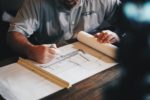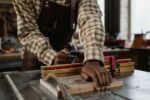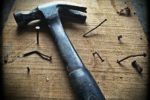How to Build a Coffee Table | 2023 Guide

Building a coffee table from scratch is an achievable project for anyone. If you’re looking to refine your DIY skills, a coffee table is one of the fundamentals of furniture-making. A bespoke coffee table is also a great alternative to one of the many of identical designs that occupy millions of homes. Below, we explain all the things you need to know when tackling a DIY wooden coffee table build.
Building the Tabletop
The easiest part of building a coffee table is putting together the tabletop. To get started, you’ll need to first cut wooden boards for the tabletop down to size. Ideally, you should be using standard 2×8 or 2×4 boards. As all of the boards that will make up the tabletop will be cut to the same length, you can use a standard hand saw here. However, if you’re not all that proficient with manual tools, you may need to do some light sanding work to ensure consistently smooth and level edges.
The number of boards you need to cut will be determined by the overall size of your planned coffee table. Once you’ve cut a sufficient number of boards down to size, you can attach them together. Attach them together lengthwise, positioning them shoulder-to-shoulder along their narrow sides. Provided you are working on a flat surface, you can use high-grade wood glue to attach these tabletop boards. When leaving the glue to dry, you may want to use clamps to keep the boards locked firmly in place.
You can next focus on creating a framed edge for your tabletop. You can use any measurement of board here, provided the thickness matches that of the boards used the tabletop. Just make sure you cut each framing board long enough that you can create a complete perimeter for your table top. Once you’ve cut the framing pieces, attach them to the exterior edges of your tabletop with wood glue. Once the glue has completely dried, you should also use nails or wood screws to secure them firmly in place.
Making the Legs
You can now focus on constructing the base of your coffee table. When making a coffee table base, 4×4 is a particularly good measurement and you can use the same wood throughout. First, cut four identical pieces that will serve as the vertical legs of your coffee table. Next, cut four shorter pieces that will be used as horizontal supports, with two pieces slotting in between each leg. You will also need cut support pieces that will run lengthwise along your coffee table base. As a minimum, you will want two on each side. However, if your tabletop is particularly large or heavy, it makes sense to add an additional support beam for added load-bearing capacity.
Once all of the legs and base pieces have been cut down, you can can assemble your coffee table frame. Start by taking two of the vertical legs and position two shorter horizontal pieces between them, making a sort of A-shape. Once you’re happy with the configuration, nail or screw the pieces into place. Repeat this step until you have two of these. These are the ends of your coffee table base. Next, you can attach the support beams to complete your coffee table base.
Sanding, Staining and Painting
Now all the building work is taken care of, you can move onto finishing your coffee table. Remove any residual glue that might be showing, before sanding the tabletop and frame. Although some people may prefer an unfinished wooden table, you should at least think about staining your bespoke furniture piece to ensure it looks its best. You may also want to apply a coat or two of furniture paint if you’re looking for a more vibrant addition to your living space.
Final Assembly
If you have stained or painted your coffee table, leave the base and tabletop to dry. If you don’t need to apply any additional coats, you can now fully assemble your new piece of furniture. The easiest way to do this is turn the tabletop over, with the underside facing upwards. Now take the frame and flip it upside down, positioning it against the underside of the tabletop. After you’ve centred the upturned frame against the tabletop, you can screw it into place.






